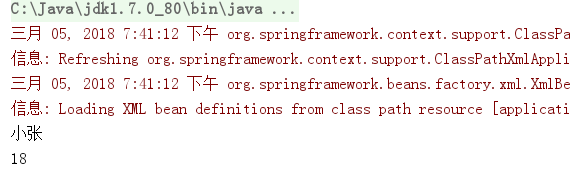DI(Dependency Injection),依赖注入是一种技术,即一个对象提供另一个对象的依赖关系。
构造注入
前提:类型必须有构造,index与参数类型保持一致
1.创建Student类
package cn.happy.day03aop.aop;
/**
* Created by Administrator on 2018/3/5.
*/
//构造注入
public class Student {
private String name;
private Integer age;
public Student() {
}
public Student(String name, Integer age) {
this.name = name;
this.age = age;
}
public String getName() {
return name;
}
public void setName(String name) {
this.name = name;
}
public Integer getAge() {
return age;
}
public void setAge(Integer age) {
this.age = age;
}
}
2.配置applicationContext.xml文件
<!--构造注入-->
<bean id="dao" class="cn.happy.day03aop.aop.Student">
<!--index 0 代表构造中的第一个参数,须与构造中的参数类型保持一致-->
<constructor-arg index="0" value="小张"></constructor-arg>
<constructor-arg index="1" value="18"></constructor-arg>
</bean>
3.编写测试类
@Test
public void SpringStructure(){
ApplicationContext ctx=new ClassPathXmlApplicationContext("applicationContext-day04di.xml");
Student service=(Student)ctx.getBean("dao");
System.out.println( service.getName()+"
"+service.getAge());
}
4.查看测试结果

p命名空间的注入
使用前要先要在applicationContext.xml配置文件中引入p命名空间
xmlns:p="http://www.springframework.org/schema/p"
1.1创建一个Car类
public class Car {
private String color;
public String getColor() {
return color;
}
public void setColor(String color) {
this.color = color;
}
}
1.2在Student类中加入一个Car类型的car属性,并封装
2.配置applicationContext.xml
<!--命名空间p注入-->
<bean id="car" class="cn.happy.day03aop.aop.Car">
<property name="color" value="red"/>
</bean>
<bean id="service" class="cn.happy.day03aop.aop.Student" p:name="小王" p:age="20" p:car-ref="car"></bean>
3.查看测试结果

集合属性注入
1.创建Mycollection类
package cn.happy.day03aop.aop;
import java.util.*;
/**
* Created by Administrator on 2018/3/5.
*/
//集合属性注入
public class Mycollection {
private String[] array;
private List<String> list;
private Set<String> set;
private Map<String,String> map;
private Properties properties;
@Override
public String toString() {
return "Mycollection{" +
"array=" + Arrays.toString(array) +
", list=" + list +
", set=" + set +
", map=" + map +
", properties=" + properties +
'}';
}
public String[] getArray() {
return array;
}
public void setArray(String[] array) {
this.array = array;
}
public List<String> getList() {
return list;
}
public void setList(List<String> list) {
this.list = list;
}
public Set<String> getSet() {
return set;
}
public void setSet(Set<String> set) {
this.set = set;
}
public Map<String, String> getMap() {
return map;
}
public void setMap(Map<String, String> map) {
this.map = map;
}
public Properties getProperties() {
return properties;
}
public void setProperties(Properties properties) {
this.properties = properties;
}
}
2.配置applicationContext.xml
<!--集合属性注入-->
<bean id="collection" class="cn.happy.day03aop.aop.Mycollection" >
<!--数组-->
<property name="array">
<array>
<value>小李</value>
<value>小王</value>
</array>
</property>
<!--集合List-->
<property name="list">
<list>
<value>小张</value>
<value>小黄</value>
</list>
</property>
<!--集合Set-->
<property name="set">
<set>
<value>小赵</value>
<value>小辉</value>
</set>
</property>
<!--集合Map-->
<property name="map">
<map>
<entry key="Y2167" value="青鸟杯"></entry>
<entry key="Y2166" value="面试题"></entry>
</map>
</property>
<!--集合Properties-->
<property name="properties">
<props>
<prop key="prop1">1</prop>
<prop key="prop2">2</prop>
</props>
</property>
</bean>
3.测试

分享完毕